January 8, 2020
I’ll have four full days at Cristalino with my 33 friends, divided into five groups. Each group has their own guide, so I decided I would just go with each group at least once, either on the morning or the afternoon outing. This morning I joined Gilmar’s group with one of the more generalist natural history groups with a stronger leaning towards birds. Serra 2 is our destination, and I hadn’t’ been there this trip yet. Like Serra 1, it’s an island of unique habitat in the middle of the forest and always holds some surprises.
The trail from the river is about a kilometer or so, and it can be hard to pick up the pace in order to maximize our time on the serra proper. Fortunately it began to rain pretty hard early on the trail, so we weren’t able to see much when there were some bird noises. But of course we still saw things, and one of the most amazing was this horsehair worm, phylum Nematomorpha, in a tiny puddle in the middle of the trail. This is the first one I’ve seen at Cristalino. It’s a parasite in arthropods, and this one presumably emerged from its katydid, grasshopper, cockroach, or some other host recently in order to find another to mate and infect future generations.
The rain stopped while we were on the serra, and we saw some excellent birds while on top (tanagers, hummingbirds, puffbirds, jacamars, etc.), but I didn’t get photos of any of them. Instead I was drawn to the amazing plants, many of which occur only here at Cristalino. One of the more unusual ones I didn’t recognize, and is still a mystery to me, is this delicate annual growing in a pocket in the rock where water collects. Some very good botanists on iNaturalist haven’t been able to place it to family either.
In the dry season you wouldn’t notice many of the plants and lichens here, but this time of year, everything is lush and colorful.
We also saw some nice frogs, and my herpetologist and photographer friend Steffen Reichle (fourth from left) got some great photos of the very localized Ameerega munduruku and Pseudopaludicola canga.
Back at the lodge for lunch, I checked up on the Suriname Horned Frog, Ceratophrys cornuta, and showed it to most of the group. This is the seventh day that it has been in this very spot.
It was unusual to have Orange-winged Parrot at the lodge grounds, even more unusual that they landed overhead by the dining hall.
The Rufous-breasted Hermit is still on her nest by the kitchen.
In the afternoon I joined the other group more into general natural history rather than birds specifically, and we went on a boat road down the Cristalino River and then around the Ariosto Island on the Teles Pires River.
On the Cristalino we stopped to see these Proboscis Bats, Rhynchonycteris naso. It was so funny when Deb finally saw them. She was still learning how to use her binoculars, but then I knew even when she aimed just right, she was looking at them without seeing them, and you can see why here. When it dawned on her what she was looking at, she was so excited she nearly fell out of the boat.
Two years ago I discovered that Passiflora riparia is a rather common species here, growing in big, thick vine tangles in the wall of vegetation along the river every few hundred meters, and it turns out that January is indeed the month to find this very little-known species.
On the Teles Pires we enjoyed watching this Drab Water Tyrant take a bath within a few meters of our boat.
Guide Jessica spotted this very distant Amazonian Umbrellabird from our boat. It could have been passed off for a crow in North America.
After dinner I offered a night walk just to see what critters might be out and about. As a group of very social, somewhat inebriated friends who hadn’t seen each other in months or even years, we were too noisy for spotting mammals. But there was still a lot to see. This tailless whipscorpion, genus Heterophrynus, is probably deaf anyway, for example.
As is this huge orbweaver, Eriophora sp.
It was a good night for frogs, and we saw at least three of these Osteocephalus leprieurii treefrogs.
It was an amazing week for Amazon Tree Boas, Corallus hortulanus. I would end up seeing at least five during my whole stay here. This is Christoph holding his first tropical American snake.
Once we were by the creek, frog diversity grew. This is a glass frog, Hyalinobatrachium cappellei. We didn’t remove it from its leaf, but if we had, we would have been able to see its bones and visceral organs through the transparent belly.
This little tree frog is apparently Dendropsophus cruzi, though the taxonomy of this group is in flux.
Kate really liked holding this White-lined Leaf Frog, Phyllomedusa vaillantii.
With our lights out at the Saleiro, someone noticed specks of light glowing in the forest understory. I assumed little beetle larvae, but they turned out to be a large group of tiny bioluminescent mushrooms in the genus Mycena. They were glowing only from the lamellae, or "gills," and were surprisingly bright.
Another fungus I noticed, though not bioluminescent, was this lovely Clavaria zollingeri.
For some reason Caspar looked on the back side of a tree trunk by the trail and found three Peanut-headed Bugs, Fulgora lampetis, always a crowd-pleaser. None of this group had ever seen anything like it, and there hadn’t been any stakeouts at Cristalino in at least a year. These will probably be here for several months. I’ll be back in August to find out.
Most members of the planthopper family Fulgoridae hold some surprise in their hind wing pattern, and this one is no exception.




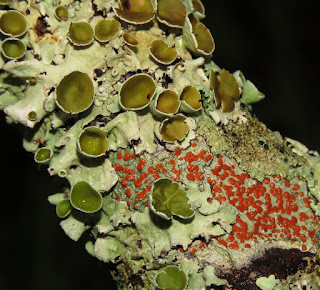



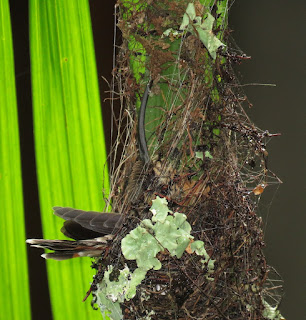

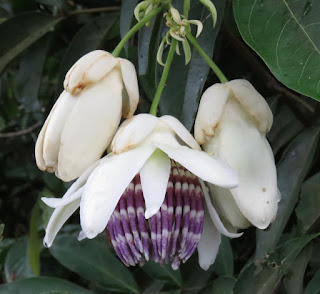
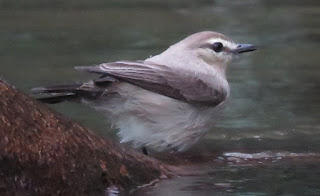




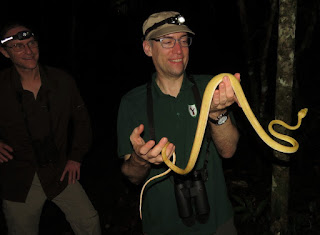

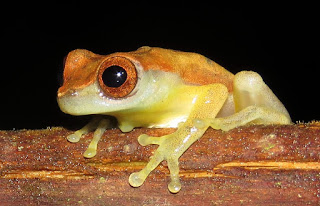

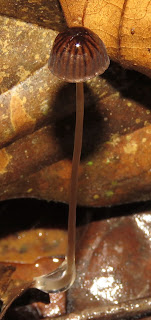

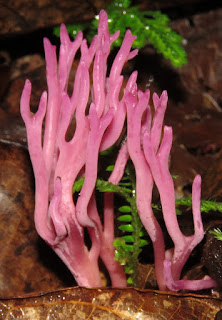

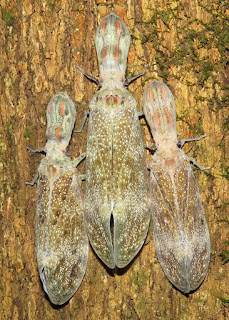
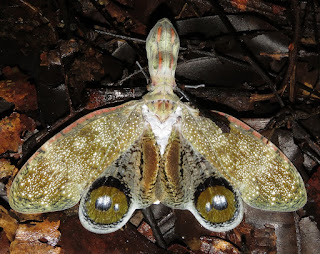





No comments:
Post a Comment